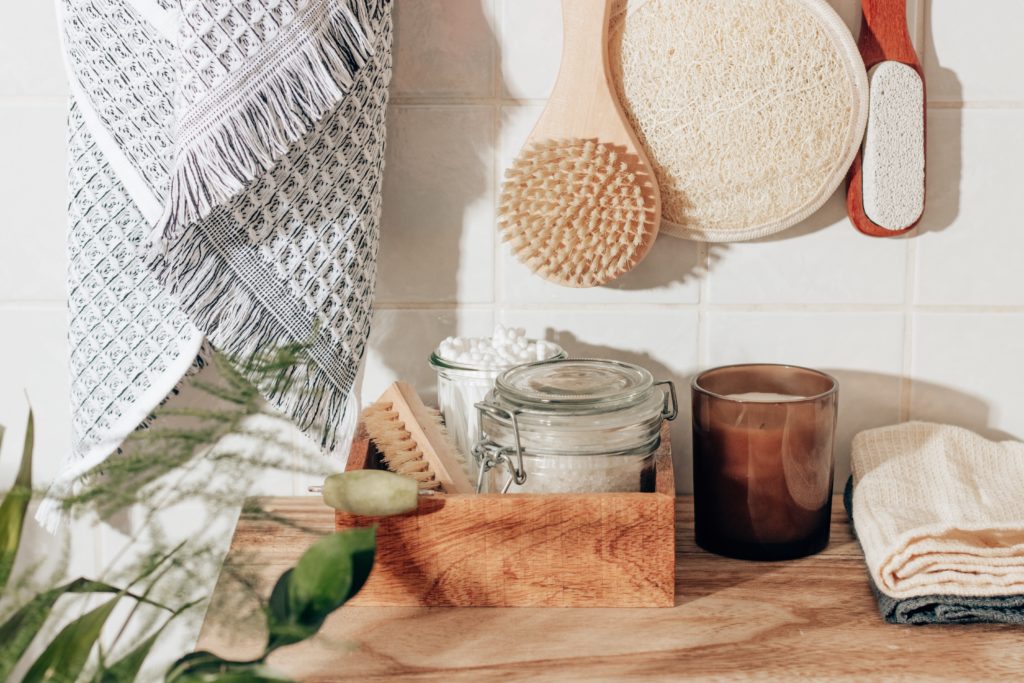
Check out these great tips for easy ways to keep sustainability in mind during your Spring Cleaning!
1) Ditch the paper towels. Switch to reusable towels. Grab some inexpensive ones, or cut up some old towels or T-shirts that are just lying around and use those as cleaning rags. Either way, you are keeping waste out of the landfill. Other great swaps for single-use items are beeswax wraps in place of saran wrap, silicone bags for snacks and food storage, and reusable shopping bags to eliminate the need for plastic and paper bags.
2) Switch to cleaning products that are nontoxic and biodegradable. Check labels to ensure that none of the cleaners you’re purchasing contain toxic chemicals. Search for products that are made from all-natural ingredients and are third-party certified as “green.” Even better, make your own! Check out this blog on DIY cleaning supplies to learn how to make your own natural cleaners that won’t fill your home with unnecessary pollutants.
3) Banish blots and blemishes, naturally. When it comes to removing tough stains, making glass gleam or clearing blockages, the eco-conscious spring cleaner has three simple solutions:
- White vinegar: Vinegar is great at cutting through grease so dip a scrunched-up sheet of newspaper in it and rub in circular motions for streak-free, sparkling windows. If your showerhead is blocked then submerging it in vinegar overnight will clear it out and, if any copper, brass or pewter is looking dull, a paste of vinegar, salt and flour scrubs tarnish away.
- Lemons: Add lemon juice to a bowl of water and pop into a filthy microwave on high for three minutes. Leave it standing for a couple more and then wipe the insides down with a dry cloth: spotless! Lemons also make a gorgeously-perfumed general cleaner when left to infuse in white vinegar for a couple of weeks.
- Baking Soda: Leave a small amount of baking soda in an open pot to eliminate stale odors from your fridge. Mix it with water to clean stainless steel, watermarks, and stove fixtures. Use a cloth to remove baked-on food from dishes and pans. Sprinkle it over a damp sponge and gently scrub marks off walls and mildew off shower curtains. Clear clogged drains by mixing it with vinegar and pouring it down plugholes.
4) Go paperless. If part of your spring-cleaning plan includes organizing your accounts, use it as an opportunity to eliminate some paper waste by opting for electronic communication. Getting your statements and correspondence online will also cut back on the amount of mail you have to sort through daily, so it’s a zero-sum game.
5) Reuse and repurpose things around the house. From using glass jars as storage containers to repurposing a cup into a toothbrush holder, there are endless ways to get creative with existing everyday items. An old toothbrush can be used to clean small corners. An old sock can be used for dusting. An old towel can be sewn into a Swiffer mop cover. If you’re willing to get creative, the possibilities are endless!
6) Find Your Hidden Clutter. It can be easy to declutter physical items like clothes, electronics etc., but have you ever thought about other places you may be holding on to clutter? Consider…
- Cleaning supplies: who needs a million different sprays and chemicals to clean? If you’re not able to DIY your cleaning supplies, consider swapping for a good all-purpose cleaner to simplify your cleaning routine.
- Digital clutter: are you someone who always has way too many tabs open on your browser, or keeps your desktop filled with file icons? You’re not alone! Research is finding that digital clutter can also lead to increased stress. The solution? Take some time or organize your email inbox, sort your files and photos and only keep what’s important. Check out the book “Digital Minimalism” to learn more!
7) Use less water. Try not to leave the water running unless you are using it or catching it in a bucket. Sweep instead of mop when you can. You can also place a tracking mat by the front door so that, in the future, you will have less mopping to do.
8) Make sure you’re using energy efficiently. It’s easy to miss some of the sneaky ways your home sucks up extra electricity, but spring cleaning provides a perfect opportunity to correct those issues. As you clean, check that nothing is plugged into an outlet unnecessarily, or plug electronics into power strips that can easily be turned off when not in use. Hang-dry your clothes and linens rather than running the dryer. Clean your refrigerator coils to increase energy efficiency. ComEd will change out all your light bulbs with LEDs, insulate pipes, install water aerators, all for free. The ComEd App also allows you to track your energy usage!
9) Compost expired food and donate the rest.
When you clean out and organize your pantry, check the expiration dates. Compost any food that is too old to eat and donate any unopened, unexpired shelf-stable goods to a local shelter. This way, nothing goes to the landfill and you help others in the process. Check out Urban Canopy and WasteNot Compost to see if they’re available in your neighborhood.
10) Give your extra or unwanted items a new home. Systematically go through your house and garage to identify things that you no longer use. Be sure to recycle or donate your unused clutter when possible so it doesn’t end up sitting in your local landfill. Rather than throw them away, consider donating them instead. Look for local resale shops like Brown Elephant which will resell the items and donate the funds towards charitable causes so you can clear out your clutter and help others in the same act.
